A Systematic Review and Meta-Analysis Investigating the Efficacy of Various Psychedelic Drugs for the Treatment of Substance Use Disorder
Abstract
1. Introduction
1.1. Psychedelics
1.2. Psilocybin
1.3. LSD
1.4. Ketamine
1.5. Ibogaine
1.6. The Current Review
2. Methods
2.1. Primary Searches
2.2. Eligibility Criteria
2.3. Search Criteria
2.4. Data Analysis
2.5. Statistical Analyses Methodology
3. Results
3.1. Description of Studies
3.2. Psilocybin
3.3. LSD
3.4. Ketamine
3.5. Ibogaine
3.6. Psilocybin, Ketamine, and Ibogaine Combined
3.7. Risk of Bias Assessment
4. Discussion
4.1. Summary of Results
4.2. Psilocybin
4.3. Ketamine
4.4. Ibogaine
4.5. LSD
4.6. Limitations
5. Conclusions
6. Implication
Author Contributions
Funding
Institutional Review Board Statement
Informed Consent Statement
Data Availability Statement
Conflicts of Interest
Appendix A
| # | Author (Date) | Psychedelic | Substance Misuse | Treatment N | Control N | Confidence Interval | Hedges g | Standard Error |
|---|---|---|---|---|---|---|---|---|
| 1 | Rieser et al., (2025) [22] | Psilocybin | Alcohol | 18 | 19 | 0.97 to 1.63 | 0.148 | 0.329 |
| 2 | Vanderijst et al., (2024) [76] | Psilocybin | Alcohol | 31 | 31 | N/A | 0.52 | N/A |
| 3 | Pagni et al., (2024) [21] | Psilocybin | Alcohol | 6 | N/A | N/A | N/A | N/A |
| 4 | Davis et al., (2023) [42] | Psilocybin | N/A | 15 | N/A | N/A | N/A | N/A |
| 5 | Agin-Liebes, (2021) [58] | Psilocybin | Alcohol | 28 | N/A | 0.82 to 1.80 | 1.31 | 0.24 |
| 6 | Bogenschutz et al., (2015) [24] | Psilocybin | Alcohol | 10 | N/A | 0.40 to 2.09 | 1.25 | 0.37 |
| 7 | Bogenschutz et al., (2022) [18] | Psilocybin | Alcohol | 49 | N/A | 1.20 to 1.95 | 1.57 | 0.19 |
| 8 | Bowen et al., (1970) [28] | LSD | Alcohol | 22 | 22 | 0.08 to 1.32 | 0.69 | 0.31 |
| 9 | Cheek et al., (1971) [74] | LSD | Alcohol | 28 | 34 | −0.26 to 0.76 | 0.25 | 0.25 |
| 10 | Hollister et al., (1969) [29] | LSD | Alcohol | 36 | 36 | 0.21 to 1.17 | 0.68 | 0.24 |
| 11 | Ludwig et al., (1969) [30] | LSD | Alcohol | 132 | 44 | −0.44 to 0.24 | −0.10 | 0.17 |
| 12 | Savage & McCabe, (1973) [34] | LSD | Narcotics | 37 | 37 | 0.01 to 0.93 | 0.47 | 0.23 |
| 13 | Smart et al., (1966) [32] | LSD | Alcohol | 10 | 20 | −0.55 to 0.99 | 0.21 | 0.38 |
| 14 | Tomsovic & Edwards (1970) [33] | LSD | Alcohol | 52 | 45 | 0.08 to 0.90 | 0.49 | 0.20 |
| 15 | Azhari et al., (2020) [59] | Ketamine | Cannabis | 8 | N/A | 1.92 to 3.68 | 2.69 | 0.39 |
| 16 | Gao et al., (2023) [36] | Ketamine | Cocaine | 3871 | 3871 | 1.42 to 2.78 | 0.58 | 0.023 |
| 17 | Dakwar et al., (2017) [60] | Ketamine | Cocaine | 10 | N/A | 1.09 to 2.83 | 1.96 | 0.38 |
| 18 | Dakwar et al., (2018) [61] | Ketamine | Cocaine | 10 | N/A | 0.60 to 2.31 | 1.45 | 0.38 |
| 19 | Dakwar et al., (2019) [62] | Ketamine | Cocaine | 27 | N/A | 1.80 to 2.84 | 2.32 | 0.25 |
| 20 | Dakwar et al., (2020) [63] | Ketamine | Alcohol | 17 | N/A | −0.16 to 1.11 | 0.47 | 0.30 |
| 21 | Das et al., (2019) [65] | Ketamine | Alcohol | 28 | N/A | 1.13 to 2.12 | 1.62 | 0.24 |
| 22 | Krupitsky et al., (2002) [66] | Ketamine | Heroin | 35 | N/A | 0.93 to 1.81 | 1.37 | 0.22 |
| 23 | Krupitsky et al., (2007) [38] | Ketamine | Heroin | 26 | N/A | 0.46 to 1.48 | 0.97 | 0.25 |
| 24 | Rothberg, (2021) [67] | Ketamine | Alcohol | 27 | N/A | 1.71 to 2.77 | 2.24 | 0.26 |
| 25 | Brown & Alper. (2018) [43] | Ibogaine | Opioids | 30 | N/A | 1.97 to 2.96 | 2.46 | 0.24 |
| 26 | Heink et al., (2017) [68] | Ibogaine | Substance use disorder | 21 | N/A | 1.78 to 2.98 | 2.38 | 0.29 |
| 27 | Malcolm et al., (2018) [69] | Ibogaine | Opioids | 50 | N/A | 1.34 to 2.08 | 1.71 | 0.18 |
| 28 | Malcolm et al., (2018) [69] | Ibogaine | Opioids | 50 | N/A | 0.84 to 1.56 | 1.20 | 0.18 |
| 29 | Noller et al., (2018) [70] | Ibogaine | Opioids | 14 | N/A | 2.48 to 3.98 | 3.23 | 0.35 |
| 30 | Schenberg et al., (2014) [64] | Ibogaine | Drug dependence | 75 | N/A | 1.03 to 1.62 | 1.33 | 0.15 |
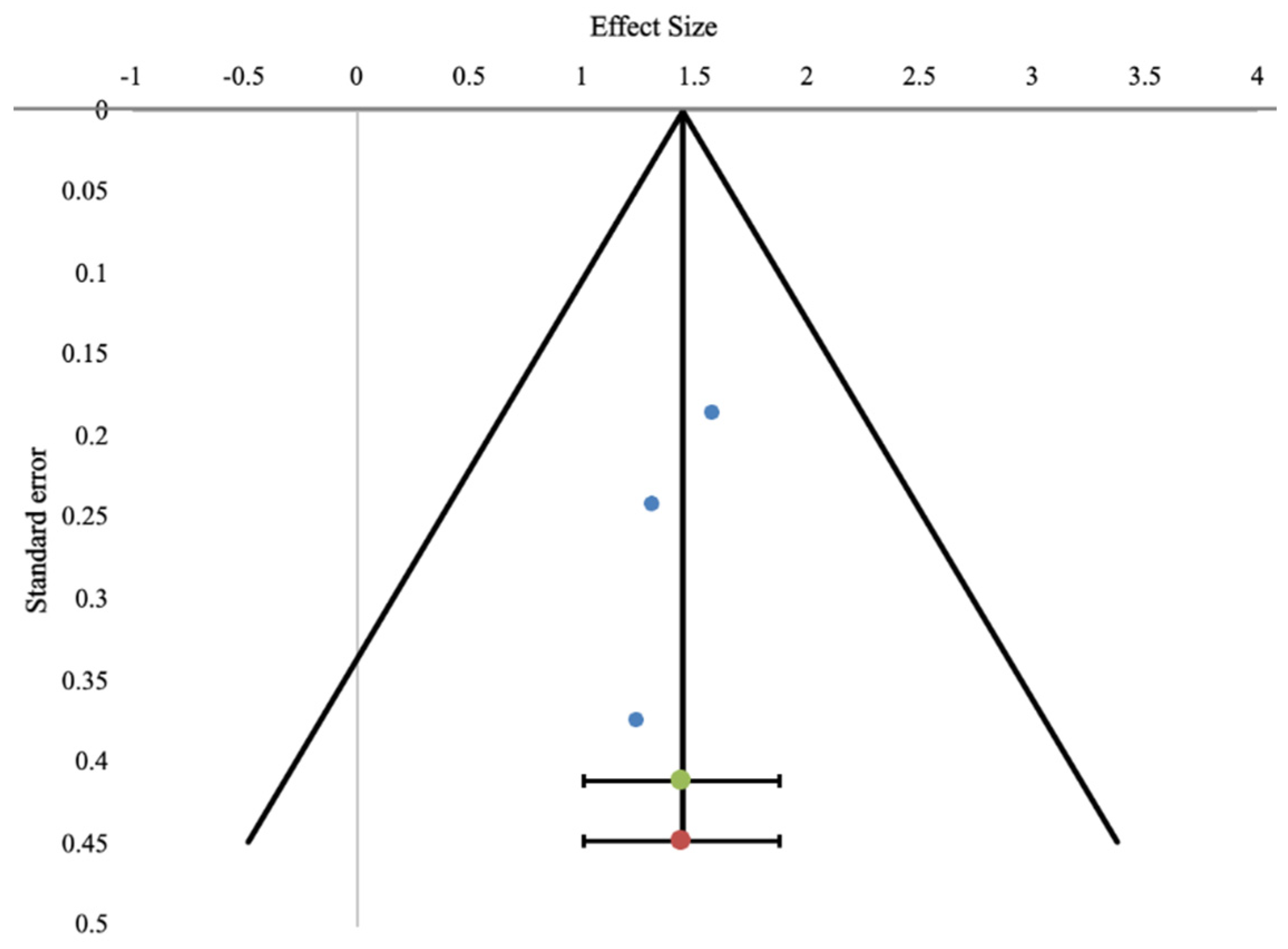
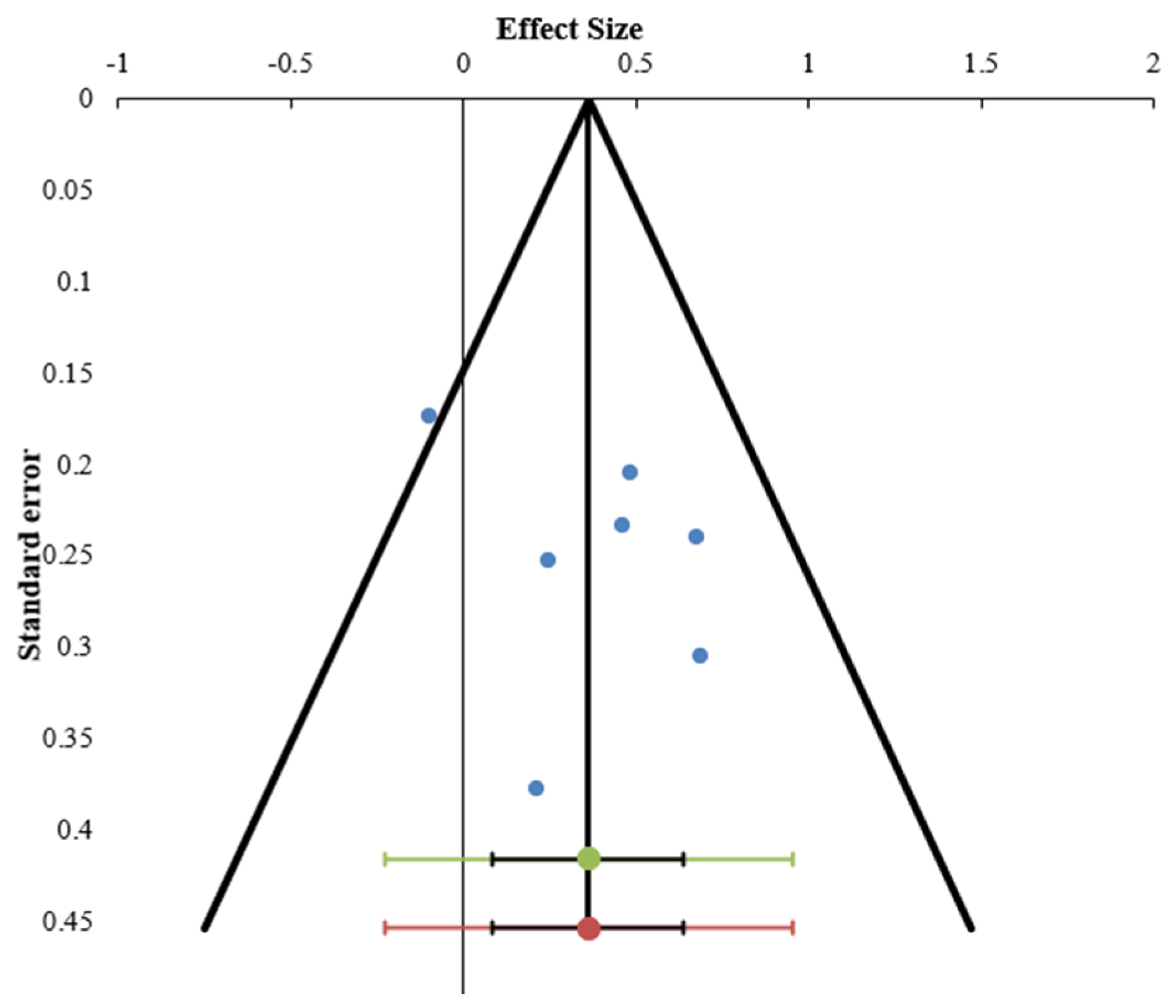
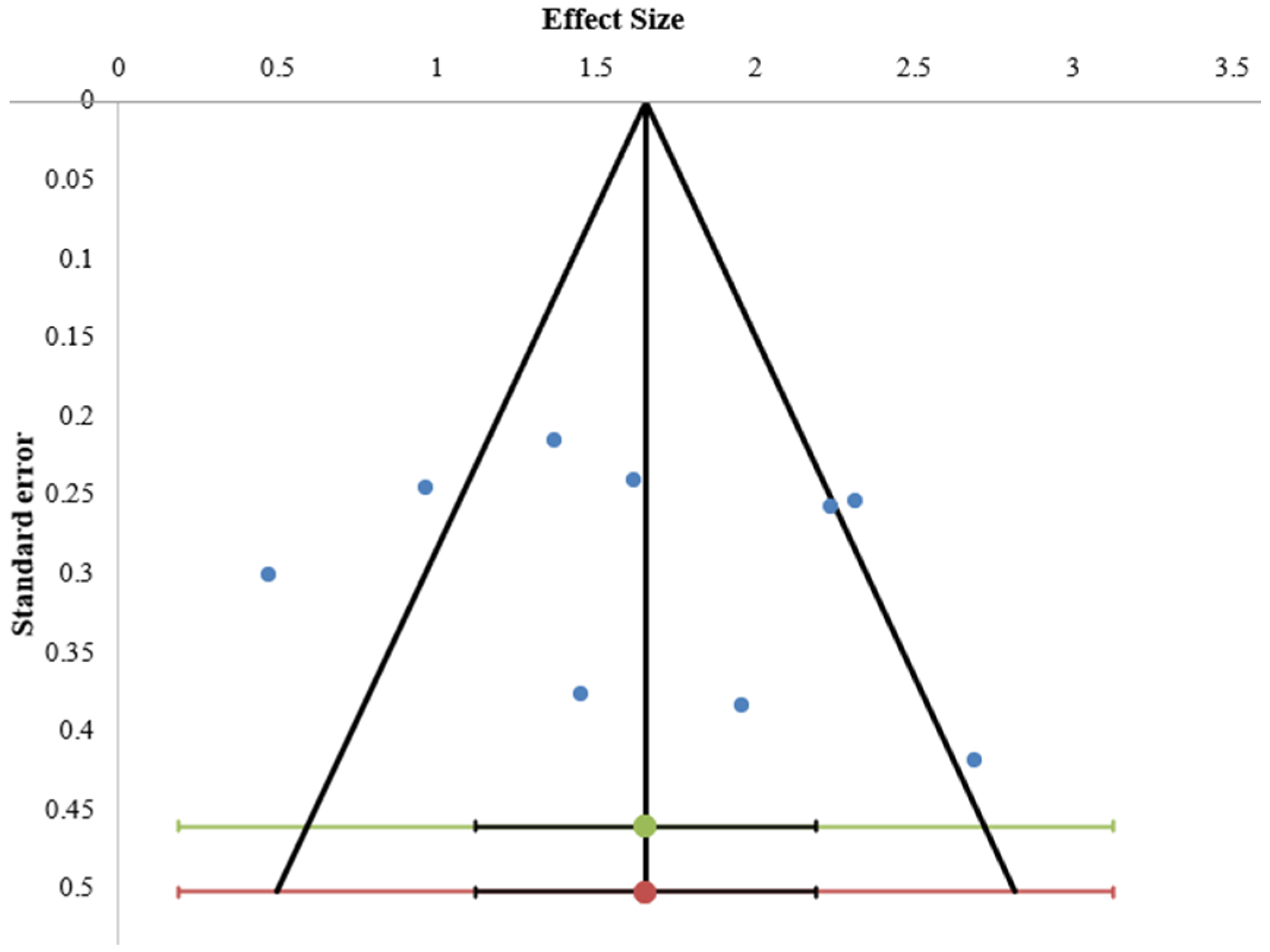

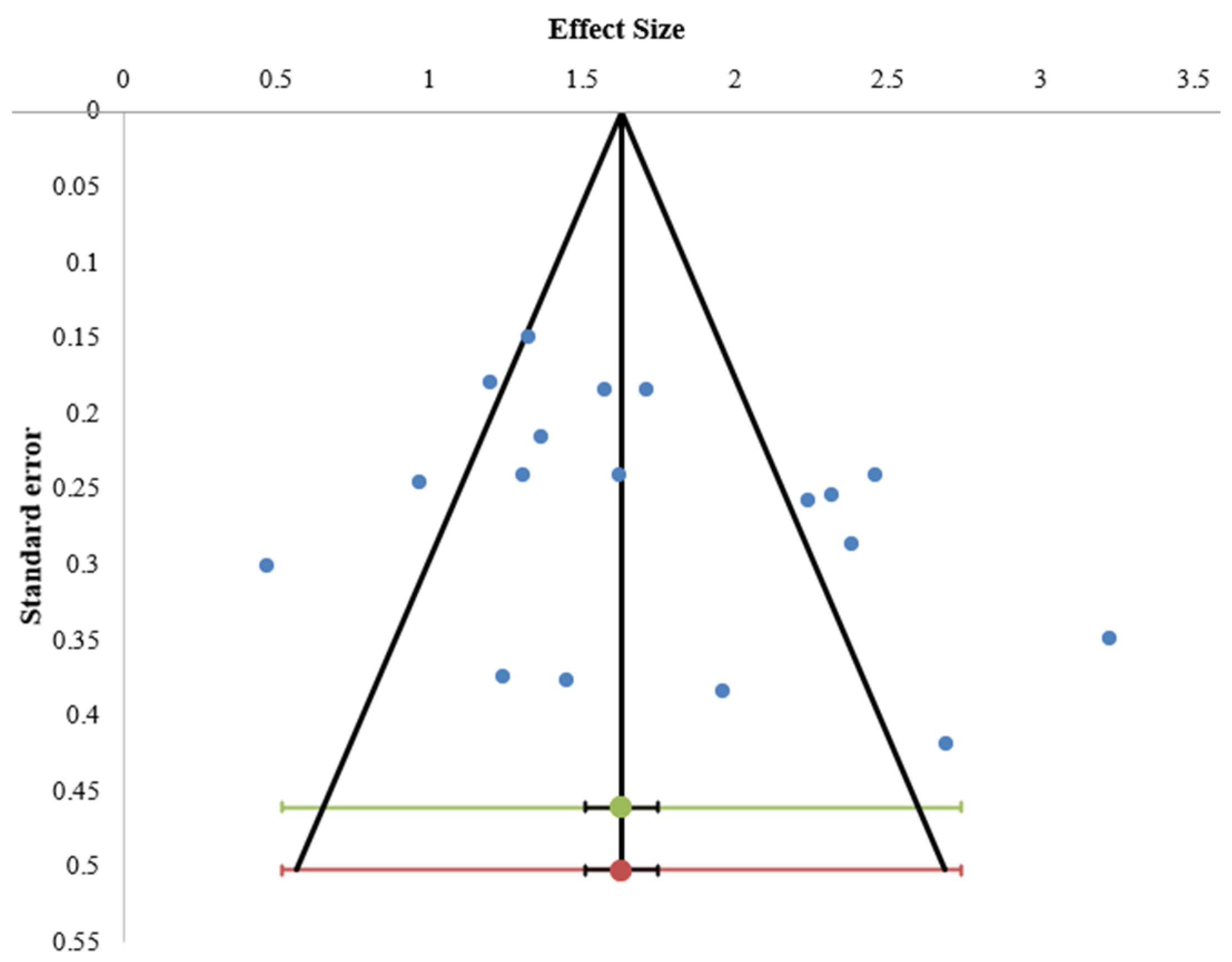
References
- Goldman, D.; Oroszi, G.; Ducci, F. The genetics of addictions: Uncovering the genes. Nat. Rev. Genet. 2005, 6, 521–532. [Google Scholar] [CrossRef]
- Gerring, Z.F.; Thorp, J.G.; Treur, J.L.; Verweij, K.J.H.; Derks, E.M. The genetic landscape of substance use disorders. Mol. Psychiatry 2024, 29, 3694–3705. [Google Scholar] [CrossRef]
- American Psychiatric Association. Diagnostic and Statistical Manual of Mental Disorders: DSM-V; American Psychiatric Pub: Washionton, DC, USA, 2013. [Google Scholar]
- United Nations Office on Drugs and Crime. World Drug Report 2023. Special Points of Interest. Available online: https://www.unodc.org/unodc/en/data-and-analysis/wdr-2023_special_points.html (accessed on 22 March 2025).
- World Health Organisation. Drugs (Psychoactive). 2022. Available online: https://www.who.int/health-topics/drugs-psychoactive#tab=tab_2 (accessed on 22 March 2025).
- Kalin, N.H. Substance Use Disorders and Addiction: Mechanisms, Trends, and Treatment Implications. Am. J. Psychiatry 2020, 177, 1015–1018. [Google Scholar] [CrossRef]
- Beaulieu, M.; Tremblay, J.; Baudry, C. A systematic review and meta-analysis of the efficacy of the long-term treatment and support of substance use disorders. Soc. Sci. Med. 2021, 285, 114289. [Google Scholar] [CrossRef]
- Nichols, D.E. Hallucinogens. Pharmacol. Ther. 2004, 101, 131–181. [Google Scholar] [CrossRef] [PubMed]
- Ko, M.; Lo, T.; Wong, C.S.M. Psychedelics, mystical experience, and therapeutic efficacy: A systematic review. Front. Psychiatry 2022, 13, 917199. [Google Scholar] [CrossRef]
- Ley, L.; Holze, F.; Arikci, D.; Becker, A.M.; Straumann, I.; Klaiber, A.; Coviello, F.; Dierbach, S.; Thomann, J.; Duthaler, U.; et al. Comparative acute effects of mescaline, LSD, and psilocybin in a randomized, double-blind, placebo-controlled, cross-over study in healthy participants. Neuropsychopharmacology 2023, 48, 1659–1667. [Google Scholar] [CrossRef]
- Van der Meer, J.; Schutten, M.; van Oorsouw, K. Therapeutic effect of psilocybin in addiction: A systematic review. Front. Psychiatry 2023, 14, 1134454. [Google Scholar] [CrossRef] [PubMed]
- Bogenschutz, M.P.; Johnson, M.W. Classic hallucinogens in the treatment of addictions. Prog. Neuro-Psychopharmacol. Biol. Psychiatry 2016, 64, 250–258. [Google Scholar] [CrossRef] [PubMed]
- Piper, T.; Small, F.; Brown, S.; Kelleher, M.; Mitcheson, L.; Rucker, J.; Young, A.H.; Marsden, J. Psychedelic-assisted treatment for substance use disorder: A narrative systematic review. Addiction 2025. Advance Online. [Google Scholar] [CrossRef]
- Martinotti, G.; De Risio, L.; Vannini, C.; Schifano, F.; Pettorruso, M.; Di Giannantonio, M. Substance-related exogenous psychosis: A postmodern syndrome. Brain Sci. 2021, 11, 856. [Google Scholar] [CrossRef]
- Hogea, L.; Tabugan, D.C.; Costea, I.; Albai, O.; Nussbaum, L.; Cojocaru, A.; Corsaro, L.; Anghel, T. The therapeutic potential of psychedelics in treating substance use disorders: A review of clinical trials. Medicina 2025, 61, 278. [Google Scholar] [CrossRef]
- Grinspoon, L.; Bakalar, J.B. Psychedelic Drugs Reconsidered; Basic Books: New York, NY, USA, 1979; Volume 168, pp. 163–166. [Google Scholar]
- Abo Hamza, E.; Gladding, S.; Moustafa, A.A. The Impact of Adolescent Substance Abuse on Family Quality of Life, Marital Satisfaction, and Mental Health in Qatar. Fam. J. Couns. Ther. Couples Fam. 2022, 30, 85–90. [Google Scholar] [CrossRef]
- Bogenschutz, M.P.; Ross, S.; Bhatt, S.; Baron, T.; Forcehimes, A.A.; Laska, E.; Mennenga, S.E.; O’Donnell, K.; Owens, L.T.; Podrebarac, S.; et al. Percentage of Heavy Drinking Days Following Psilocybin-Assisted Psychotherapy vs Placebo in the Treatment of Adult Patients with Alcohol Use Disorder: A Randomized Clinical Trial. JAMA Psychiatry 2022, 79, 953–962. [Google Scholar] [CrossRef] [PubMed]
- Mangini, M. Treatment of Alcoholism Using Psychedelic Drugs: A Review of the Program of Research. J. Psychoact. Drugs 1998, 30, 381–418. [Google Scholar] [CrossRef] [PubMed]
- de Veen, B.T.H.; Schellekens, A.F.A.; Verheij, M.M.M.; Homberg, J.R. Psilocybin for treating substance use disorders. Expert Rev. Neurother. 2017, 17, 203–212. [Google Scholar] [CrossRef] [PubMed]
- Pagni, B.A.; Petridis, P.D.; Podrebarac, S.K.; Grinband, J.; Claus, E.D.; Bogenschutz, M.P. Psilocybin-induced changes in neural reactivity to alcohol and emotional cues in patients with alcohol use disorder: An fMRI pilot study. Sci. Rep. 2024, 14, 3159. [Google Scholar] [CrossRef]
- Rieser, N.M.; Bitar, R.; Halm, S.; Rossgoderer, C.; Gubser, L.P.; Thévenaz, M.; Kreis, Y.; von Rotz, R.; Nordt, C.; Visentini, M.; et al. Psilocybin-assisted therapy for relapse prevention in alcohol use disorder: A phase 2 randomized clinical trial. EClinicalMedicine 2025, 82, 103149. [Google Scholar] [CrossRef]
- Holze, F.; Singh, N.; Liechti, M.E.; D’Souza, D.C. Serotonergic psychedelics: A comparative review of efficacy, safety, pharmacokinetics, and binding profile. Biol. Psychiatry Cogn. Neurosci. Neuroimaging 2024, 9, 472–489. [Google Scholar] [CrossRef]
- Bogenschutz, M.P.; Forcehimes, A.A.; Pommy, J.A.; Wilcox, C.E.; Barbosa, P.C.; Strassman, R.J. Psilocybin-assisted treatment for alcohol dependence: A proof-of-concept study. J. Psychopharmacol. 2015, 29, 289–299. [Google Scholar] [CrossRef]
- Hendricks, P.S. Psilocybin treatment of cocaine use disorder. In Proceedings of the College on Problems of Drug Dependence 80th Annual Scientific Meeting, San Diego, CA, USA, 9–14 June 2018; The College on Problems of Drug Dependence: Brentwood, TN, USA, 2018. [Google Scholar]
- Krebs, T.S.; Johansen, P. Lysergic acid diethylamide (LSD) for alcoholism: Meta-analysis of randomised controlled trials. J. Psychopharmacol. 2012, 26, 994–1002. [Google Scholar] [CrossRef]
- Zafar, R.; Siegel, M.; Harding, R.; Barba, T.; Agnorelli, C.; Suseelan, S.; Roseman, L.; Wall, M.; Nutt, D.J.; Erritzoe, D. Psychedelic therapy in the treatment of addiction: The past, present and future. Front. Psychiatry 2023, 14, 1183740. [Google Scholar] [CrossRef] [PubMed]
- Bowen, W.T.; Soskin, R.A.; Photos, J.W. Lysergic acid diethylamide as a variable in the hospital treatment of al-coholism. J. Nerv. Ment. Dis. 1970, 150, 111–118. [Google Scholar] [CrossRef]
- Hollister, L.E.; Shelton, J.; Krieger, G. A controlled comparison of lysergic acid diethylamide (LSD) and dextroamphetamine in alcoholics. Am. J. Psychiatry 1969, 125, 1352–1357. [Google Scholar] [CrossRef]
- Ludwig, A.; Levine, J.; Stark, L.; Lazar, R. A clinical study of LSD treatment in alcoholism. Am. J. Psychiatry 1969, 126, 59–69. [Google Scholar] [CrossRef]
- Pahnke, W.N.; Kurland, A.A.; Unger, S.; Savage, C.; Grof, S. The experimental use of psychedelic (LSD) psychotherapy. JAMA 1970, 212, 1856–1863. [Google Scholar] [CrossRef]
- Smart, R.G.; Storm, T.; Baker, E.F.; Solursh, L. A controlled study of lysergide in the treatment of alcoholism. 1. The effects on drinking behaviour. Q. J. Stud. Alcohol 1966, 27, 469–482. [Google Scholar] [CrossRef] [PubMed]
- Tomsovic, M.; Edwards, R.V. Lysergide Treatment of Schizophrenic and Nonschizophrenic Alcoholics; A Controlled Evaluation. Q. J. Stud. Alcohol 1970, 31, 932–949. [Google Scholar] [CrossRef] [PubMed]
- Savage, C.; McCabe, O.L. Residential psychedelic (LSD) therapy for the narcotic addict. A controlled study. Arch. Gen. Psychiatry 1973, 28, 808–814. [Google Scholar] [CrossRef]
- Garcia-Romeu, A.; Davis, A.K.; Erowid, E.; Erowid, F.; Griffiths, R.R.; Johnson, M.W. Persisting Reductions in Cannabis, Opioid, and Stimulant Misuse After Naturalistic Psychedelic Use: An Online Survey. Front. Psychiatry 2020, 10, 955. [Google Scholar] [CrossRef]
- Gao, Z.; Winhusen, T.J.; Gorenflo, M.; Ghitza, U.E.; Davis, P.B.; Kaelber, D.C.; Xu, R. Repurposing ketamine to treat cocaine use disorder: Integration of artificial intelligence-based prediction, expert evaluation, clinical corroboration and mechanism of action analyses. Addiction 2023, 118, 1307–1319. [Google Scholar] [CrossRef]
- Ettensohn, M.F.; Markey, S.M.; Levine, S.P. Considering Ketamine for Treatment of Comorbid Pain, Depression, and substance use disorders. Psychiatr. Ann. 2018, 48, 180–183. [Google Scholar] [CrossRef]
- Krupitsky, E.M.; Burakov, A.M.; Dunaevsky, I.V.; Romanova, T.N.; Slavina, T.Y.; Grinenko, A.Y. Single versus repeated sessions of ketamine-assisted psychotherapy for people with heroin dependence. J. Psychoact. Drugs 2007, 39, 13–19. [Google Scholar] [CrossRef] [PubMed]
- Jones, G.; Ricard, J.A.; Lipson, J.; Nock, M.K. Associations between classic psychedelics and opioid use disorder in a nationally representative U.S. adult sample. Sci. Rep. 2022, 12, 4099. [Google Scholar] [CrossRef] [PubMed]
- Alper, K.R.; Lotsof, H.S.; Frenken, G.M.; Luciano, D.J.; Bastiaans, J. Treatment of acute opioid withdrawal with ibogaine. Am. J. Addict. 1999, 8, 234–242. [Google Scholar] [CrossRef]
- Wong, S.; Yu, A.Y.; Fabiano, N.; Finkelstein, O.; Pasricha, A.; Jones, B.D.M.; Rosenblat, J.D.; Blumberger, D.M.; Mulsant, B.H.; Husain, M.I. Beyond Psilocybin: Reviewing the Therapeutic Potential of Other Serotonergic Psychedelics in Mental and Substance Use Disorders. J. Psychoact. Drugs 2023, 56, 513–529. [Google Scholar] [CrossRef]
- Davis, A.K.; Levin, A.W.; Nagib, P.B.; Armstrong, S.B.; Lancelotta, R.L. Study protocol of an open-label proof-of-concept trial examining the safety and clinical efficacy of psilocybin-assisted therapy for veterans with PTSD. BMJ Open 2023, 13, e068884. [Google Scholar] [CrossRef]
- Brown, T.K.; Alper, K. Treatment of opioid use disorder with ibogaine: Detoxification and drug use outcomes. Am. J. Drug Alcohol Abus. 2018, 44, 24–36. [Google Scholar] [CrossRef]
- Sharma, B.; Batchelor, R.; Sin, J. Psychedelic Treatments for Substance Use Disorder and Substance Misuse: A Mixed Methods Systematic Review. J. Psychoact. Drugs 2023, 55, 612–630. [Google Scholar] [CrossRef]
- Mind Medicine Australia. Our Progress to Date. 2022. Available online: https://mindmedicineaustralia.org.au/ (accessed on 22 March 2025).
- Covidence Systematic Review Software. Veritas Health Innovation, Melbourne, Australia. 2022. Available online: www.covidence.org (accessed on 22 March 2025).
- Page, M.J.; Moher, D.; Bossuyt, P.M.; Boutron, I.; Hoffmann, T.C.; Mulrow, C.D.; Shamseer, L.; Tetzlaff, J.M.; Akl, E.A.; Brennan, S.E.; et al. PRISMA 2020 explanation and elaboration: Updated guidance and exemplars for reporting systematic reviews. BMJ 2021, 372, n160. [Google Scholar] [CrossRef]
- Tawfik, G.M.; Dila, K.A.S.; Mohamed, M.Y.F.; Tam, D.N.H.; Kien, N.D.; Ahmed, A.M.; Huy, N.T. A step by step guide for conducting a systematic review and meta-analysis with simulation data. Trop. Med. Health 2019, 47, 46. [Google Scholar] [CrossRef]
- Sterne, J.A.C.; Savović, J.; Page, M.J.; Elbers, R.G.; Blencowe, N.S.; Boutron, I.; Cates, C.J.; Cheng, H.-Y.; Corbett, M.S.; Eldridge, S.M.; et al. RoB 2: A revised tool for assessing risk of bias in randomized trials. BMJ 2019, 366, l4898. [Google Scholar] [CrossRef]
- Suurmond, R.; van Rhee, H.; Hak, T. Introduction, comparison, and validation of Meta-Essentials: A free and simple tool for meta-analysis. Res. Synth. Methods 2017, 8, 537–553. [Google Scholar] [CrossRef] [PubMed]
- Wilson, D.B. Practical Meta-Analysis Effect Size Calculator, Version 2023.11.27. Campbell Collaboration Online Tool. George Mason University: Fairfax, VA, USA, 2023.
- Villacura-Herrera, C.; Kenner, N. rESCMA: A brief summary on effect size conversion for meta-analysis. OSF Preprints 2020. [Google Scholar] [CrossRef]
- Cohen, J. Statistical Power Analysis for the Behavioural Sciences, 2nd ed.; Erlbaum: Hillsdale, NJ, USA, 1988. [Google Scholar]
- Barili, F.; Parolari, A.; Kappetein, P.A.; Freemantle, N. Statistical Primer: Heterogeneity, random-or fixed-effects model analyses? Interact. Cardiovasc. Thorac. Surg. 2018, 27, 317–321. [Google Scholar] [CrossRef]
- Higgins, J.P.; Thompson, S.G. Quantifying heterogeneity in a meta-analysis. Stat. Med. 2002, 21, 1539–1558. [Google Scholar] [CrossRef]
- Higgins, J.P.; Thompson, S.G.; Deeks, J.J.; Altman, D.G. Measuring inconsistency in meta-analyses. Bmj 2003, 327, 557–560. [Google Scholar] [CrossRef]
- Duval, S.; Tweedie, R. A nonparametric “trim and fill” method of accounting for publication bias in meta-analysis. J. Am. Stat. Assoc. 2000, 95, 89–98. [Google Scholar] [CrossRef] [PubMed]
- Agin-Liebes, G. The Role of Self-Compassion in Psilocybin-Assisted Motivational Enhancement Therapy to Treat Alcohol Dependence: A Randomized Controlled Trial (Order No. 27541708). Available from ProQuest Central; ProQuest Disserta-tions & Theses Global. (2506309915). 2020. Available online: https://ezproxy.bond.edu.au/login?url=https://www.proquest.com/dissertations-theses/role-self-compassion-psilocybin-assisted/docview/2506309915/se-2 (accessed on 22 March 2025).
- Azhari, N.; Hu, H.; O’Malley, K.Y.; Blocker, M.E.; Levin, F.R.; Dakwar, E. Ketamine-facilitated behavioural treatment for cannabis use disorder: A proof of concept study. Am. J. Drug Alcohol Abus. 2020, 47, 92–97. [Google Scholar] [CrossRef]
- Dakwar, E.; Hart, C.L.; Levin, F.R.; Nunes, E.V.; Foltin, R.W. Cocaine self-administration disrupted by the N-methyl-D-aspartate receptor antagonist ketamine: A randomized, crossover trial. Mol. Psychiatry 2017, 22, 76–81. [Google Scholar] [CrossRef]
- Dakwar, E.; Nunes, E.V.; Hart, C.L.; Hu, M.C.; Foltin, R.W.; Levin, F.R. A sub-set of psychoactive effects may be critical to the behavioural impact of ketamine on cocaine use disorder: Results from a randomized, controlled laboratory study. Neuropharmacology 2018, 142, 270–276. [Google Scholar] [CrossRef]
- Dakwar, E.; Nunes, E.V.; Hart, C.L.; Foltin, R.W.; Mathew, S.J.; Carpenter, K.M.; Choi, C.J.J.; Basaraba, C.N.; Pavlicova, M.; Levin, F.R. A Single Ketamine Infusion Combined with Mindfulness-Based Behavioural Modification to Treat Cocaine Dependence: A Randomized Clinical Trial. Am. J. Psychiatry 2019, 176, 923–930. [Google Scholar] [CrossRef]
- Dakwar, E.; Levin, F.; Hart, C.L.; Basaraba, C.; Choi, J.; Pavlicova, M.; Nunes, E.V. A Single Ketamine Infusion Combined with Motivational Enhancement Therapy for Alcohol Use Disorder: A Randomized Midazolam-Controlled Pilot Trial. Am. J. Psychiatry 2020, 177, 125–133. [Google Scholar] [CrossRef]
- Schenberg, E.E.; de Castro Comis, M.A.; Chaves, B.R.; da Silveira, D.X. Treating drug dependence with the aid of ibogaine: A retrospective study. J. Psychopharmacol. 2014, 28, 993–1000. [Google Scholar] [CrossRef] [PubMed]
- Das, R.K.; Gale, G.; Walsh, K.; Hennessy, V.E.; Iskandar, G.; Mordecai, L.A.; Brandner, B.; Kindt, M.; Curran, H.V.; Kamboj, S.K. Ketamine can reduce harmful drinking by pharmacologically rewriting drinking memories. Nat. Commun. 2019, 10, 5187. [Google Scholar] [CrossRef]
- Krupitsky, E.; Burakov, A.; Romanova, T.; Dunaevsky, I.; Strassman, R.; Grinenko, A. Ketamine psychotherapy for heroin addiction: Immediate effects and two-year follow-up. J. Subst. Abus. Treat. 2002, 23, 273–283. [Google Scholar] [CrossRef]
- Rothberg, R.L.; Azhari, N.; Haug, N.A.; Dakwar, E. Mystical-type experiences occasioned by ketamine mediate its impact on at-risk drinking: Results from a randomized, controlled trial. J. Psychopharmacol. 2021, 35, 150–158. [Google Scholar] [CrossRef]
- Heink, A.; Katsikas, S.; Lange-Altman, T. Examination of the Phenomenology of the Ibogaine Treatment Experience: Role of Altered States of Consciousness and Psychedelic Experiences. J. Psychoact. Drugs 2017, 49, 201–208. [Google Scholar] [CrossRef]
- Malcolm, B.J.; Polanco, M.; Barsuglia, J.P. Changes in Withdrawal and Craving Scores in Participants Undergoing Opioid Detoxification Utilizing Ibogaine. J. Psychoact. Drugs 2018, 50, 256–265. [Google Scholar] [CrossRef] [PubMed]
- Noller, G.E.; Frampton, C.M.; Yazar-Klosinski, B. Ibogaine treatment outcomes for opioid dependence from a twelve-month follow-up observational study. Am. J. Drug Alcohol Abus. 2018, 44, 37–46. [Google Scholar] [CrossRef] [PubMed]
- Olami, A.; Peled-Avron, L. Effects of classical psychedelics on implicit and explicit emotional empathy and cognitive empathy: A meta-analysis of MET task. Sci. Rep. 2024, 14, 24480. [Google Scholar] [CrossRef]
- Hanji, M.B. Meta-Analysis in Psychiatry Research: Fundamental and Advanced Methods; Apple Academic Press, Inc.: Palm Bay, FL, USA, 2017. [Google Scholar]
- Egger, M.; Smith, G.D.; Schneider, M.; Minder, C. Bias in meta-analysis detected by a simple, graphical test. BMJ 1997, 315, 629–634. [Google Scholar] [CrossRef]
- Cheek, F.E.; Holstein, C.M. Lysergic acid diethylamide tartrate (LSD-25) dosage levels, group differences and social interaction. J. Nerv. Ment. Dis. 1971, 153, 133–147. [Google Scholar] [CrossRef]
- Harrer, M.; Cuijpers, P.; Furukawa, T.A.; Ebert, D.D. Doing Meta-Analysis with R: A Hands-On Guide; Chapman & Hall: Boca Raton, FL, USA; London, UK, 2021. [Google Scholar]
- Vanderijst, L.; Hever, F.; Buot, A.; Dauré, C.; Benoit, J.; Hanak, C.; Veeser, J.; Morgiève, M.; Campanella, S.; Kornreich, C.; et al. Psilocybin-assisted therapy for severe alcohol use disorder: Protocol for a double-blind, randomized, placebo-controlled, 7-month parallel-group phase II superiority trial. BMC Psychiatry 2024, 24, 77. [Google Scholar] [CrossRef]
- Moustafa, A.A.; Tindle, R.; Cashel, S.; Parkes, D.; Mohamed, E.; Abo Hamza, G. Bidirectional relationship between heroin addiction and depression: Behavioural and neural studies. Curr. Psychol. 2020, 41, 5195–5211. [Google Scholar] [CrossRef]
- Argento, E.; Socias, M.E.; Hayashi, K.; Choi, J.; Mackay, L.; Christie, D.; Milloy, M.J.; DeBeck, K. Psychedelic use is associated with reduced daily opioid use among people who use illicit drugs in a Canadian setting. Int. J. Drug Policy 2022, 100, 103518. [Google Scholar] [CrossRef]
- Pisano, V.D.; Putnam, N.P.; Kramer, H.M.; Franciotti, K.J.; Halpern, J.H.; Holden, S.C. The association of psychedelic use and opioid use disorders among illicit users in the United States. J. Psychopharmacol. 2017, 31, 606–613. [Google Scholar] [CrossRef] [PubMed]
- Grabski, M.; McAndrew, A.; Lawn, W.; Marsh, B.; Raymen, L.; Stevens, T.; Hardy, L.; Warren, F.; Bloomfield, M.; Borissova, A.; et al. Adjunctive Ketamine with Relapse Prevention-Based Psychological Therapy in the Treatment of Alcohol Use Disorder. Am. J. Psychiatry 2022, 179, 152–162. [Google Scholar] [CrossRef] [PubMed]
- Rieser, N.M.; Herdener, M.; Preller, K.H. Psychedelic-Assisted Therapy for Substance Use Disorders and Potential Mechanisms of Action. Curr. Top. Behav. Neurosci. 2022, 56, 187–211. [Google Scholar] [CrossRef]
- Alper, K.R.; Lotsof, H.S. The use of ibogaine in the treatment of addictions. In Psychedelic Medicine: New Evidence for Hallucinogenic Substances as Treatments; Winkelman, M.J., Roberts, T.B., Eds.; Praeger Publishers/Greenwood Publishing Group: Westport, CT, USA, 2007; Volume 2, pp. 43–66. [Google Scholar]
- Corkery, J.M. Ibogaine as a treatment for substance misuse: Potential benefits and practical dangers. Prog. Brain Res. 2018, 242, 217–257. [Google Scholar] [CrossRef] [PubMed]
- Snelders, S.; Kaplan, C. LSD therapy in Dutch psychiatry: Changing socio-political settings and medical sets. Med. Hist. 2002, 46, 221–240. [Google Scholar] [CrossRef]
- Sledge, W.H.; Hutchinson, J. Psychotherapy and Psychosocial Interventions in the Treatment of Substance Abuse. In Psychotherapy Is Worth It: A Comprehensive Review of Its Cost-Effectiveness; Lazar, S.G., Ed.; American Psychiatry Publishing: Washington, DC, USA, 2010; pp. 175–186. [Google Scholar]
- Johnson, M.W.; Garcia-Romeu, A.; Cosimano, M.P.; Griffiths, R.R. Pilot study of the 5-HT2AR agonist psilocybin in the treatment of tobacco addiction. J. Psychopharmacol. 2014, 28, 983–992. [Google Scholar] [CrossRef]
- Grob, C.S.; Danforth, A.L.; Chopra, G.S.; Hagerty, M.; McKay, C.R.; Halberstadt, A.L.; Greer, G.R. Pilot study of psilocybin treatment for anxiety in patients with advanced-stage cancer. Arch. Gen. Psychiatry 2011, 68, 71–78. [Google Scholar] [CrossRef]
- Liao, Y.; Tang, Y.-l.; Hao, W. Ketamine and international regulations. Am. J. Drug Alcohol Abus. 2017, 43, 495–504. [Google Scholar] [CrossRef] [PubMed]
- Rodger, S.; Puspanathan, P.; Simpson, B.S.; Reuber, M.; Grunewald, R.A. Ketamine for depression: A systematic review. Adv. Psychiatr. Treat. 2021, 27, 85–94. [Google Scholar]
- Shapiro, B. Ibogaine: History, pharmacology, spirituality, & clinical data. In Integrative Addiction and Recovery; Modi, S.J., Munoz, G.E., Eds.; Oxford University Press: New York, NY, USA, 2018; pp. 447–460. [Google Scholar]
- Chappendijk, F.G.; Dzoljic, M.R. Inhibitory effects of ibogaine on morphine self-administration in rats. Eur. J. Pharmacol. 1994, 241, 261–265. [Google Scholar] [CrossRef] [PubMed]
- Ibogaine Australia. 2019. Available online: https://www.ibogaine.net.au/ (accessed on 14 November 2022).
- Abuzzahab, F.S.; Anderson, B.J. A review of LSD treatment in alcoholism. Int. Pharmacopsychiatry 1971, 6, 223–235. [Google Scholar] [CrossRef]
- Fuentes, J.J.; Fonseca, F.; Elices, M.; Farré, M.; Torrens, M. Therapeutic use of LSD in psychiatry: A systematic review of randomised-controlled clinical trials. Front. Psychiatry 2020, 943, 494327. [Google Scholar] [CrossRef]
- Wyborn, C.; Louder, E.; Harrison, J.; Montambault, J.; Montana, J.; Ryan, M.; Hutton, J. Understanding the impacts of research synthesis. Environ. Sci. Policy 2018, 86, 72–84. [Google Scholar] [CrossRef]
- Skvarc, D.R.; Fuller-Tyszkiewicz, M. Calculating repeated-measures meta-analytic effects for continuous outcomes: A tutorial on pretest–posttest–controlled designs. Adv. Methods Pract. Psychol. Sci. 2024, 7, 1–13. [Google Scholar] [CrossRef]
- Boot, W.R.; Simons, D.J.; Stothart, C.; Stutts, C. The pervasive problem with placebos in psychology: Why active control groups are not sufficient to rule out placebo effects. Perspect. Psychol. Sci. 2013, 8, 445–454. [Google Scholar] [CrossRef] [PubMed]
- Reitsma, J.B.; Rutjes, A.W.S.; Whiting, P.; Vlassov, V.V.; Leeflang, M.M.G.; Deeks, J.J. Assessing Methodological Quality. Cochrane Handbook for Systematic Reviews of Diagnostic Test Accuracy Version. Available online: http://srdta.cochrane.org/ (accessed on 22 March 2025).
- Yusuf, S.; Wittes, J.; Probstfield, J.; Tyroler, H.A. Analysis and interpretation of treatment effects in subgroups of patients in randomized clinical trials. JAMA 1991, 266, 93–98. [Google Scholar] [CrossRef]
- Fletcher, J. Subgroup analyses: How to avoid being misled. BMJ 2007, 335, 96–97. [Google Scholar] [CrossRef]
- Puspanathan, P. Psychedelic research in Australia: Breaking through the stigma. Aust. N. Z. J. Psychiatry 2017, 51, 940–941. [Google Scholar] [CrossRef] [PubMed]
- Dunn, M. Can Illicit Drugs Be Used for Legitimate Treatment Purposes? 2016. Available online: www.news.com.au/technology/science/humanbody/psychedelics-and-MDMA-are-helpingcure-PTSD-addiction-depression-and-anxiety/news-story/15f3f6c1256255629e8a23d20cb80fcc (accessed on 15 November 2022).
- Abo Hamza, E.; Moustafa, A.A. Motivational interviewing for the treatment of addiction. In Cognitive, Clinical, and Neural Aspects of Drug Addiction, 1st ed.; Moustafa, A.A., Ed.; Elsevier: Amsterdam, The Netherlands, 2020; pp. 289–313. [Google Scholar]
- Warren, S.L.; Reid, E.; Whitfield, P.; Helal, A.M.; Abo Hamza, E.G.; Tindle, R.; Moustafa, A.A.; Hamid, M.S. Cognitive and behavioral abnormalities in individuals with Alzheimer’s disease, mild cognitive impairment, and subjective memory complaints. Curr. Psychol. 2024, 43, 800–810. [Google Scholar] [CrossRef]





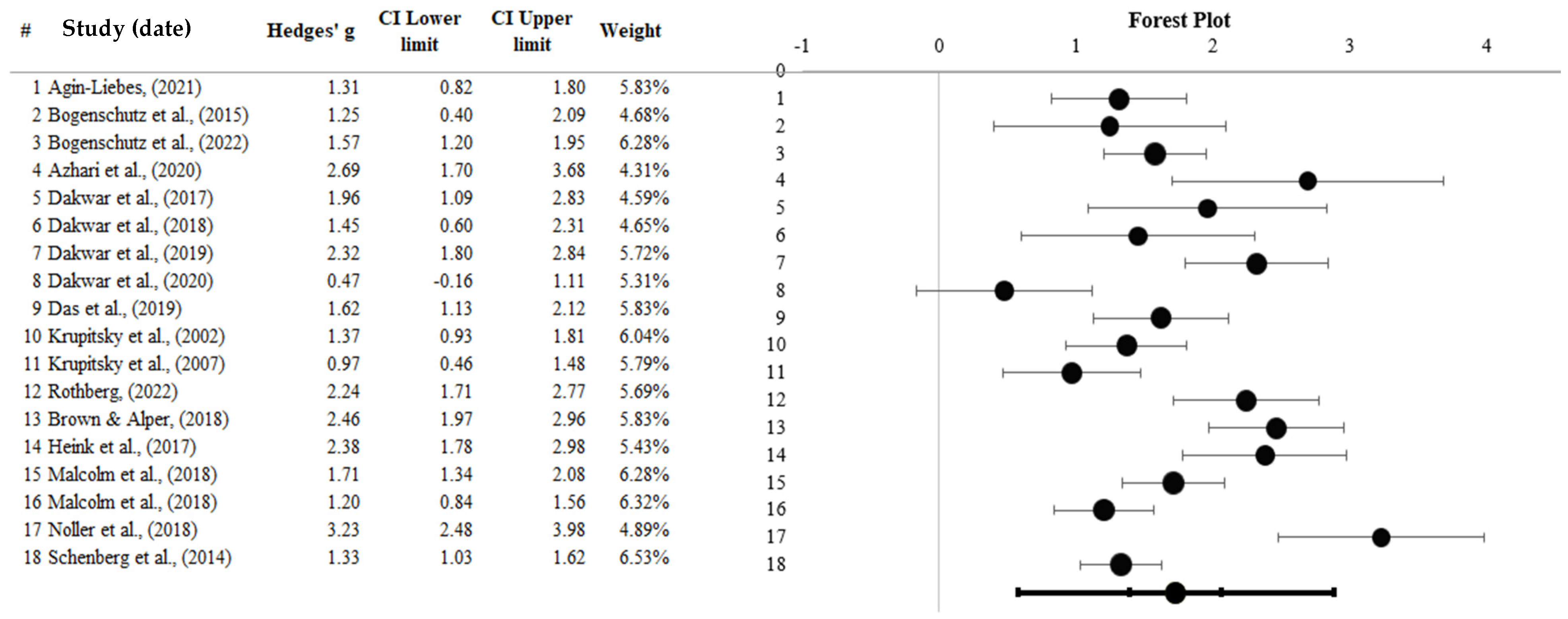
Disclaimer/Publisher’s Note: The statements, opinions and data contained in all publications are solely those of the individual author(s) and contributor(s) and not of MDPI and/or the editor(s). MDPI and/or the editor(s) disclaim responsibility for any injury to people or property resulting from any ideas, methods, instructions or products referred to in the content. |
© 2025 by the authors. Licensee MDPI, Basel, Switzerland. This article is an open access article distributed under the terms and conditions of the Creative Commons Attribution (CC BY) license (https://creativecommons.org/licenses/by/4.0/).
Share and Cite
Keighley, E.E.; Abo Hamza, E.; Bedewy, D.A.; Nalla, S.; Moustafa, A.A. A Systematic Review and Meta-Analysis Investigating the Efficacy of Various Psychedelic Drugs for the Treatment of Substance Use Disorder. Healthcare 2025, 13, 2668. https://doi.org/10.3390/healthcare13212668
Keighley EE, Abo Hamza E, Bedewy DA, Nalla S, Moustafa AA. A Systematic Review and Meta-Analysis Investigating the Efficacy of Various Psychedelic Drugs for the Treatment of Substance Use Disorder. Healthcare. 2025; 13(21):2668. https://doi.org/10.3390/healthcare13212668
Chicago/Turabian StyleKeighley, Eve E., Eid Abo Hamza, Dalia A. Bedewy, Shahed Nalla, and Ahmed A. Moustafa. 2025. "A Systematic Review and Meta-Analysis Investigating the Efficacy of Various Psychedelic Drugs for the Treatment of Substance Use Disorder" Healthcare 13, no. 21: 2668. https://doi.org/10.3390/healthcare13212668
APA StyleKeighley, E. E., Abo Hamza, E., Bedewy, D. A., Nalla, S., & Moustafa, A. A. (2025). A Systematic Review and Meta-Analysis Investigating the Efficacy of Various Psychedelic Drugs for the Treatment of Substance Use Disorder. Healthcare, 13(21), 2668. https://doi.org/10.3390/healthcare13212668






